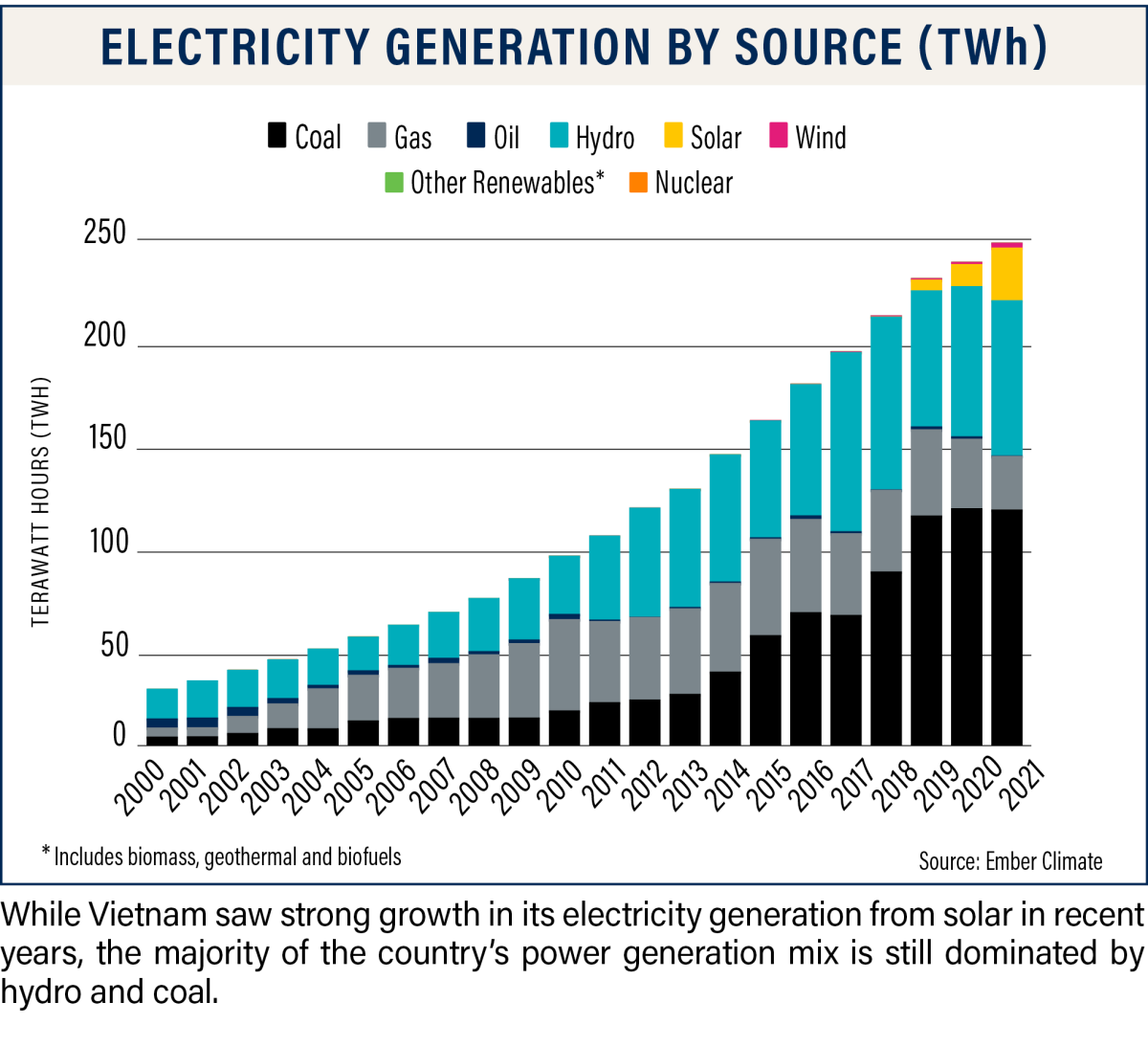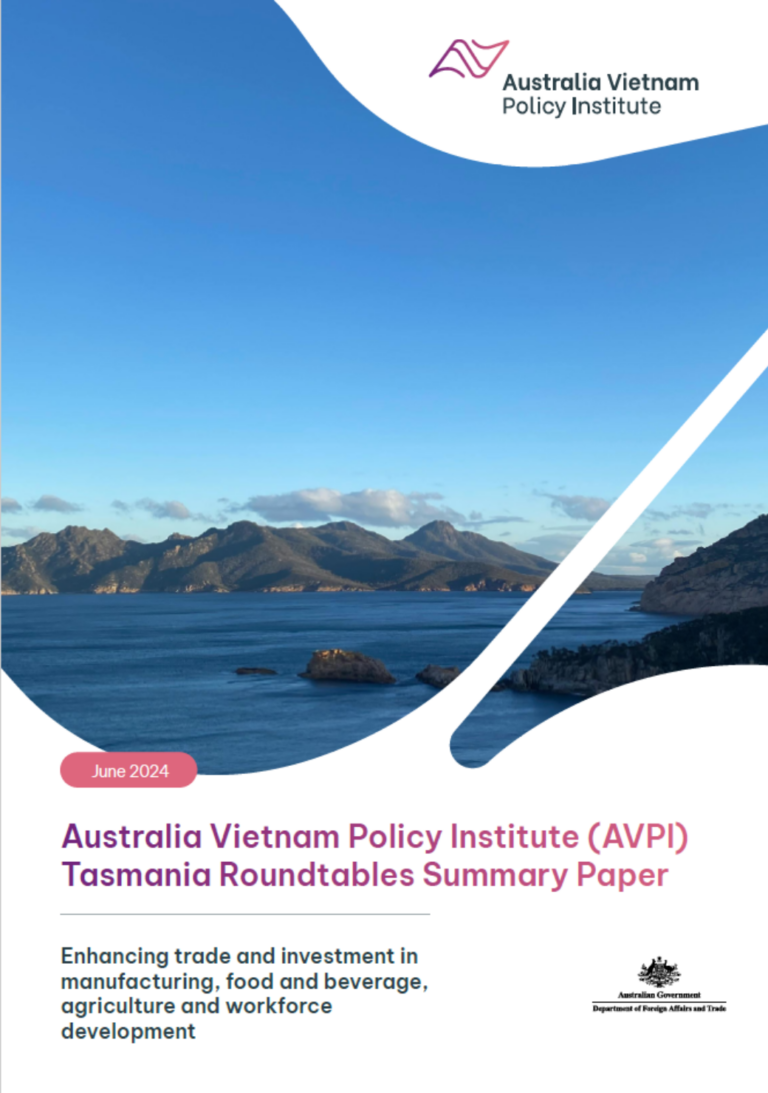Vietnam has been ranked among the world's top five countries most vulnerable to climate change due to its long coastline, low-lying areas, and generally warmer climate.
The country faces high risks from sea-level rise, flooding, drought, and other extreme weather events that threaten its socioeconomic development and environmental sustainability. More than two-thirds of its population lives along the coast or in major deltas where most economic activities are concentrated, including manufacturing, agriculture, and transportation. These sectors are highly sensitive to climate change impacts, yet they also account for a large share of Vietnam’s greenhouse gas (GHG) emissions. Vietnam’s total GHG emissions reached 438.11 million tons of CO2-equivalent (MtCO2e) in 2019 (including land use, land-use change, and forestry (LULUCF)), ranking eighth in the Asia-Pacific region.
Vietnam has been proactive in developing climate policy since ratifying the Kyoto Protocol in 2002, issuing a series of legislation, national strategies, and action plans. Notably, Vietnam’s National Green Growth Strategy was adopted in 2012. It aimed to reduce GHG intensity per unit of GDP by 8% – 10% compared to 2010 levels between 2011 and 2020, and to reduce total GHG emissions by at least 1.5% – 2% annually until 2030 compared to business as usual (BAU) (conditional on receiving international support). The 2012 strategy was replaced and updated in 2021 for 2021–2030. The updated version aims to reduce GHG intensity per unit of GDP by at least 15% by 2030 compared to 2014 levels.
Vietnam has made significant commitments to reduce its GHG emissions based on the process established by the Paris Agreement. In its first NDC submission in 2016, Vietnam pledged to reduce its GHG emissions by 8% compared to BAU by 2030 using its own resources, and up to 25% with international support. In its first NDC update submitted in 2020, Vietnam increased its unconditional target to 9% and its conditional target to 27%. The total emissions reduction in its unconditional target would equate to 83.9 MtCO2 by 2030.

While agriculture has remained a primary GHG emissions source since 1990 due to Vietnam’s growing rice and livestock production, the country’s energy sector in 2016 surpassed agriculture as the highest-emitting sector, accounting for almost one-third of the country’s GHG emissions. Vietnam is one of the world’s biggest coal consumers, and its power sector generated 38% of its electricity from coal in 2022, representing an increase from 33% in 2015. The share of renewable power generation was more than 30% in 2020, but it was dominated by large hydropower that accounted for more than 80% of the renewable power supply.
Still, Vietnam has made remarkable progress in developing other renewable energy, especially solar power. The country increased its solar capacity from zero in 2015 to 16.6 GW in 2020. At the same time, the transportation sector has also been a focal issue for the government over the past years. Tax incentives for EV buyers were put in place to encourage the adoption of zero-emission vehicles.
Recent developments
At COP26 in Glasgow, Prime Minister Pham Minh Chinh for the first time announced that Vietnam would aim to achieve net zero emissions by 2050 using both domestic resources and support from the international community. Vietnam also signed the Global Coal to Clean Power Transition statement, which includes pledges to phase out coal-fired power plants by the 2040s, end new unabated coal power permitting and construction, and further deploy renewable energy. In addition, the government also joined the U.S.- and EU-led Global Methane Pledge, the UK-led Leaders’ Declaration on Forests and Land Use, and the Global Forest Finance Pledge. Following Vietnam’s endorsement of the Global Methane Pledge, the country also devised its Methane Action Plan 2030 outlining its strategy to reduce methane emissions, especially from agriculture and waste management. The plan sets specific targets for reducing overall methane emissions by 2025 (13.34% reduction from 2020 levels) and 2030 (30% reduction from 2020 levels).
Building on its commitments at COP26, the Vietnamese government established its National Steering Committee in December 2021 to devise a comprehensive strategy and action plan for realizing net zero emissions by 2050. In April 2022 prior to COP27, the government unveiled the National Climate Change Strategy for 2050, which is the first official document to set out the country’s vision and goals for mitigating and adapting to climate change and transitioning to a net zero society. Besides net zero and energy transition pledges, the country also commits to a 70% reduction in LULUCF emissions and to maintain tree cover at 43% by 2050. In the same year, a revised Law on Environmental Protection that mandates the design of a domestic emissions trading scheme (ETS) entered into force, and a decree that outlines steps toward launching a domestic ETS was simultaneously issued.
At COP27, Vietnam also submitted its second NDC update, in which its unconditional target was raised to 15.8% reduction by 2030, relative to BAU, and its conditional target was raised to 43.5% reduction by 2030. Moreover, Vietnam reaffirmed its long-term objective of achieving net zero by 2050, as initially outlined in the National Climate Change Strategy to 2050, unveiled in July 2022. The NDC update also notes that the country plans to decrease its methane emissions by 30% in 2030 compared to 2020 levels, aligning with the Global Methane Pledge. Beyond these commitments, Vietnam has further announced that it has undertaken a range of efforts geared towards reducing GHG emissions and enhancing carbon sequestration within the LULUCF sector.
In the wake of COP27, Vietnam made further progress in its green transition with the approval of the Just Energy Transition Partnership (JET-P) with the International Partners Group (IPG) in December 2022. The JET-P aims to support Vietnam’s net zero by 2050 goal by mobilizing $15.5 billion of public and private finance to help achieve its various energy transition targets, with $7.75 billion coming from IPG members and international financial institutions, and the other $7.75 billion from private financial institutions. As part of the deal, Vietnam also agreed to accelerate its projected GHG emissions peaking date from 2035 to 2030 and to reduce peak annual power sector emissions by up to 30% by 2030. If the JET-P pledges are fully implemented, the share of renewables overall could reach 66.5% by 2030.
In May 2023, Vietnam’s latest National Power Development Plan (PDP8) was adopted after two years of delay, setting the most ambitious targets yet for increasing the share of renewable energy and peaking GHG emissions by 2030. According to the plan, the share of renewable generation capacity in the power sector will reach nearly 50% by 2030. Meanwhile, the share of coal generation capacity will decline to approximately 20% by 2030, despite an absolute increase in capacity from 21 GW in 2020 to 30 GW in 2030. Vietnam has planned a total phaseout of coal power capacity by 2050.
Reading between the lines
Although Vietnam has formally promulgated a net zero target into policy, which is a significant step forward, its updated 2030 target in its latest NDC submitted in 2022 remains insufficient for meeting either Paris Agreement goal to limit global temperature increases to well below 2 degrees and pursue efforts limit increases to 1.5 degrees Celsius. According to Climate Action Tracker, when taking into account its fair share, Vietnam would still need to reduce emissions to 350 MtCO2e by 2030, a level of emissions nearly 2.5 times lower than the 902 MtCO2e that would be achieved based on Vietnam’s unconditional target. More ambitious near- and mid-term targets may thus be needed to maintain Paris alignment and stay on track to reach net zero by 2050.

One of the most important challenges for Vietnam, as it is for many other fast-developing economies in achieving their emissions reduction targets, is to facilitate a rapid transition toward clean energy sources for power generation while ensuring the security and reliability of the electricity supply. The current power shortages in Vietnam, affecting major industrial parks and residential areas, provide further immediacy to addressing this challenge. A key aspect of tackling this challenge is to mobilize large-scale investment in clean energy projects, especially from the domestic and foreign private sectors. This, in turn, depends on the implementation of necessary regulatory and market reforms, as well as financial innovations, to create an enabling environment that encourages private participation in the development of clean energy technologies and systems, as well as the incubation of clean energy innovation and new business models for market introduction.
It is also worth noting that facilitating these reforms and financial innovations requires careful planning and consideration of cross-cutting issues, which can take a significant amount of time. This partly explains why coal-fired power plants, liquefied natural gas (LNG) power plants, and hydropower plants will continue to play an important, transitional role in the near term (up to 2030) before wind and solar power and other innovative clean energy technologies can replace them to occupy a central place in the country’s power sector by mid-century, as outlined in the PDP8. This necessitates the development of a sound and effective long-term plan for decommissioning or converting these fossil fuel power assets.
As coal continues to play a dominant role, accounting for 20% of power generation by 2030, coordinated coal plant retirement plans need to be devised for the long-term net zero targets, as well as significant funding. The government has estimated that power plant and grid connectivity constructions will require an additional $134.7 billion by 2030 from both domestic and international sources. The JET-P will be able to play an important role in facilitating this transition, but additional resources will still be needed.
Apart from the power sector, decarbonization plans for other sectors (e.g., agriculture, industry, waste, LULUCF) have also been included in Vietnam’s NDC and latest announcements. As of writing, Vietnam is one of the first developing countries that has published a detailed methane action plan that adopts solutions for agricultural production.
Ensuring transparency and effective governance will also be critical to securing a just transition. Many countries most vulnerable to climate change effects, including Vietnam, exhibit high levels of perceived public service corruption. A global alliance of 36 civil society organizations urged supporters of the JET-P to request that Vietnam free activists who have been jailed unjustly and ensure that civil society in Vietnam is involved in both the conceptualization and oversight of the deal’s implementation.
What to watch for next
Implementing PDP8 will be pivotal for Vietnam’s decarbonization this decade. To expand wind and solar energy capacity and reduce hydropower reliance, Vietnam will need to update its infrastructure, including the national grid system, to prevent production losses and manage supply fluctuations. Vietnam saw the curtailment of 500 GWh of solar photovoltaic (PV) power back in 2021 due to limited grid capacity. With wind power emerging as an upcoming trend in Vietnam, the enhancement of grid capacity must be prioritized. Like many other regions, energy storage technologies (e.g., battery storage, green hydrogen) are important options for improving the flexibility of the power grids in Southeast Asia. While they could potentially make a great impact on improving the country’s grid flexibility, battery storage technologies are only expected to be cost-competitive in Vietnam by 2030 without adequate financing and technical support.
As Vietnam sets out more ambitious national action plans and policies, it will be critical to secure more financing to deliver these goals. Carbon pricing could help supplement other resources. A pilot voluntary ETS is expected to start in 2026 or 2027 that initially takes into account the power sector, followed by a fully operational system in 2028. On clean energy, thanks to its long coastline, Vietnam also has significant potential for offshore wind power, up to 500 GW capacity. This capacity could potentially serve as a reliable and consistent energy source, comparable to the base load currently provided by coal power generation. However, fully harnessing this potential would require significant investments, considering that Vietnam’s existing wind power capacity currently stands at slightly below four GW. The implementation of the JET-P could be helpful in tapping into this potential.
At the same time, it will be vital for Vietnam to accelerate efforts in other economic sectors. Despite its updated NDC, Vietnam still lacks decarbonization plans for its major industries, such as cement, steel, and ammonia production. The steel sector, for example, is estimated to be the one most impacted by the European Union’s carbon border adjustment mechanism (CBAM); Vietnam will need to mitigate the CBAM’s impacts by reducing the emissions intensities of its exported products. Developing plans could address adopting cleaner technologies, improving energy efficiency, and increasing the use of renewable and clean energy sources.
Moreover, although tax incentives for EVs have been adopted in recent years, Vietnam could accelerate the transition to 100% zero-emission vans and cars by setting concrete targets or joining existing initiatives, such as the Declaration on Accelerating the Transition to 100% Zero Emission Vans and Cars or the Zero-Emission Government Fleet Declaration.
This article was originally published by the Asia Society Policy Institute, the policy branch of Founding Partner, Asia Society Australia. To view the original article please click here.













